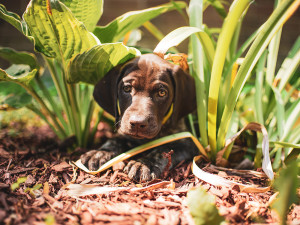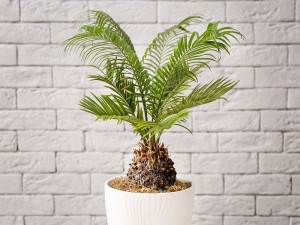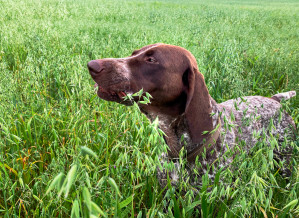Are Hydrangeas Toxic to My Dog?
You can live your best New England cottage life. Just keep your dog away from this plant.
Hydrangeas are a common garden plant. If you’re a novice at gardening, you’ve probably been told this is an easy one to start with. They’re versatile, aren’t picky about where you plant them, and are hardy enough to withstand someone with a less-than-green thumb.
Unfortunately, hydrangeas are known to be toxic to dogs if they eat the plant. In most cases, the signs tend to be mild, and they will make a full recovery. Read on to learn about hydrangea toxicity.
Why are hydrangeas dangerous to dogs?
Hydrangeas contain a toxic compound called cyanogenic glycoside, which can make dogs sick when they eat it. In most cases, this results in a mild toxicity with digestive upset. It can also make people, cats, and other animals sick if they eat the plant. In very rare cases, when a large amount of certain species of Hydrangea are consumed, it could cause cyanide poisoningopens in new tab. This is a much more serious toxicity that can cause grave health problems including death. It is primarily a risk for grazing animals like cows, horses, goats, and sheep.
Hydrangeas are beautiful shrubs with clusters of blue, pink, and purple flowers. They are often used in picturesque landscaping designs; picture your classic stone cottage in a charming New England seaside town where your dogs run free in an open meadow and their fur blows luxuriously in the breeze. Or maybe you have a more humble hydrangea in a pot on your fire escape.
How much do you spend on your pet per year?
Either way, these perennial shrubs have lush green foliage with beautiful clusters of flowers that make them very popular for gardens. They are part of the Hydrangeaceae family with some varieties native to the US and/or Asia. They may also be called French Hydrangeas, Hortensias, Bigleaf Hydrangeas, Snowball plants, or Mophead Hydrangeas. There are at least six commonly cultivated varieties of the plant. Hydrangea macrophylla is the only one that has been clearly documented to contain cyanogenic glycosides. For the other varieties, this has not been fully studied. It is safest to assume any variety of hydrangea may contain these toxic compounds and should not be ingested by animals or people.
What should I do if my dog has eaten a hydrangea?
If you see your dog eating a piece of the plant or actively trying to eat it, do your best to take it away from them. You can try to lure your pup away with something yummy to eat or a favorite toy. If your pup drops the plant, you can remove as much of the plant debris from their reach as possible.
If you think your dog may have eaten a large amount of the plant, contact your vet and a pet poison control hotlineopens in new tab to discuss their recommendations. The plan will likely depend on how much you suspect your pup ate, as well as any symptoms your dog is already showing.
Diagnosing Plant Poisoning in Dogs
The clearest way to identify plant toxicity is to directly observe your dog eating the plant. Many signs of plant toxicities are vague, and they could be the same signs you might see from a number of different health problems. It is often tricky to determine the exact cause of their illness if you did not see your dog eating the plant. Most vet clinics cannot test for specific plant toxins so the diagnosis is made based on a dog’s history of exposure to the plant, as well as the specific signs of illness they are showing.
If you are concerned that your pet is sick from eating a specific plant, try to bring a sample of the plant or a photo of the plant when you bring your dog to the vet so you can provide as much information as possible. Any time you are concerned that your dog is sick or just not acting right, it is best to have them checked out by a vet. Even if you are unsure whether they ate something funky like a toxic plant, or whether you think their signs are likely to resolve on their own, your vet can help figure it out and monitor for the more serious signs of illness.
Symptoms of Hydrangea Poisoning in Dogs
In most cases, hydrangea ingestion will cause digestive upset for dogs. In very rare cases, some varieties of Hydrangea could also cause cyanide poisoning if a large amount of the plant is consumed. This is more of a risk in farm animals, however it is good to know what to watch for.
Vomiting: The cyanogenic glycoside toxin in hydrangeas can cause gastrointestinal upset. This can lead to nausea and vomiting. Dogs may also eat less, or not want to eat at all if they are nauseated.
Diarrhea: As the plant matter is broken down and the toxin is released, it can also lead to disruptions in normal intestinal function and cause diarrhea. Sometimes, the diarrhea may contain blood. Your dog may need to poop with more urgency than normal so try to offer extra walks throughout the day and night. Consider confining your dog to an area of your home that is easy to clean in case of accidents.
Depression: Medically-speaking, dogs that are lethargic, more quiet than normal, and are withdrawn from interactions with other people and pets are described as having “depressed mentation.” This is different from depression as a mental illness in humans, and is more of a physical sign of feeling weak, tired, and generally unwell. This may be the result of feeling nauseated and/or having belly pain from the hydrangea ingestion. It should resolve along with the other signs of illness your dog is experiencing.
Cyanide Toxicity: While this would be a very rare outcome of hydrangea ingestion, it is good to know what to look out for. Signs of cyanide toxicity include dilated pupils, difficulty breathing, tremors, seizures, and/or collapse. These signs occur rapidly; within an hour or less of eating the plant. Any of these signs would be indications to get your dog to a vet right away.
Treatment
In most cases of hydrangea toxicity, dogs should recover on their own without a need for medical attention, as long as their symptoms are limited to mild vomiting and/or diarrhea. Your pup should be feeling much better within 24 hours. You can try to feed your dog small portions of a bland diet, such as steamed white meat chicken and white rice, for a few days until their signs are completely resolved, and then gradually transition back to their normal dog food.
Make sure your dog is eating and drinking consistently to avoid dehydration. If your dog is acting like they are in pain, not eating, is very lethargic, and/or has more serious signs such as difficulty breathing, tremors, seizures, or collapse, you should seek veterinary care right away. Treatment may include anti-nausea medications, fluids to rehydrate them, and/or more intensive care if they are showing signs of cyanide toxicity.
How to Prevent Hydrangea Poisoning
The best way to avoid hydrangea toxicity is to keep your pup from getting their paws on these plants. Plant dog-safe plants in your garden instead of hydrangeas so you don’t have to worry if your dog gets a taste of something while exploring. If you just can’t give up on your New England cottage fantasy, be sure to keep the hydrangeas far out of reach of your pets.
Fence off an area of the yard where your dog can safely play and explore and then plant Hydrangeas and any other potentially toxic plants outside of this zone. If you can’t break up your outdoor space, plan to keep your dog on the leash whenever they are outside and always supervise your dog’s outside time to make sure they are not getting into any toxic plants or other dangers on your property.
Are all parts of the hydrangea poisonous to dogs?
The entire plant is poisonous. In order for the toxins to be released, the plant must be chewed on, so dogs will only be at risk if they are gnawing on the plant or trying to eat it. Most of the time, dogs do not grind up the plant efficiently enough to release cyanide, so this is why it typically just causes a mild toxicity. In cases where the plant is already stressed, such as if it is wilted or diseased, the cyanide may become more easily accessible. For this reason, it is best to keep the plant completely off limits to your pup.
How do I stop my dog from eating hydrangeas?
The best option is to keep your garden free from toxic plants including hydrangeas, especially if you have a very curious dog that tastes first and asks questions later. The next best option is to provide your pup with an enclosed dog run where they can play safely outside in an area blocked off from toxic plants and other dangers that may be lurking on your property.
Of course, there are times when your pup may be outside beyond the confines of your property, and there may be toxic plants like hydrangeas out in the world. Cue that New England cottage scene and your dog’s luscious mane blowing in the sea breeze.
For these outdoor adventures, you can work on training your dog to respond to a “leave it”
cue so that if you encounter plants or other dangerous objects outside of your home, you can quickly redirect your pup to safer activities. It is also always a good idea to keep your dog on-leash when you are exploring new places. This will allow you to scout out any possible dangers to your pup and guide them to safer spots. While some parks and hiking trails may allow dogs to be off-leash, it is best to keep your dog on-leash unless you are sure your dog can safely navigate the area without major risks to themselves, other dogs, and/or other people.
The bottom line: Are hydrangeas poisonous to dogs?
Hydrangeas are poisonous to dogs. While most cases will cause mild vomiting and diarrhea, there is a very small risk of more serious illness if cyanide poisoning occurs. It is always a good practice to try to dog-proof your yard as well as your home to keep your pup safe from known toxins, including certain plants.
Other Garden Plants That Are Safe For Dogs:
There are lots of garden plants that are safe to grow around your pup, so consider adding some of these instead of the more toxic varieties.
Rosemary can be grown outside or inside the home. It likes dry soil and lots of sun, so it can be a perfect summer accessory in your herb garden. You can even dry the leaves to use in cooking year round.
Bromeliads are typically found outdoors in more tropical settings, so if you live somewhere that is warm all year, this can be a great choice. Even if your area gets cold in the winter, you can grow some bromeliads outdoors in the summer months for a taste of the tropics. Pineapple plants are part of this family, and you can actually grow a whole new pineapple plant from the leftover leaves and stem of the fruit. If you are into free plants, this one is definitely for you.
Oat and wheat grasses can be a fun addition to a dog-safe garden because they are actually safe for your pup to chew on and eat in small amounts. They grow quickly so you can start them from seeds and make your dog their own little garden patch to chew on, dig in, or of course, pee on.
Other Garden Plants That Are Dangerous For Dogs:
If you are in the market for some new landscaping gems be sure to double check whether or not they are toxic to your petsopens in new tab. There are some popular garden plants that can cause serious illness and/or injury to pets and it is best to avoid them. This includes:
Sago Palm: These plants contain a toxin called cycasin, which can cause serious illness and even death when ingested.
Foxtails: These are seeds from certain grasses that can get stuck in your dog’s fur and skin and migrate anywhere throughout their body. While most gardeners don’t plant these intentionally, be sure to check your outdoor space for these and remove them if you see any to keep your pup from getting injured.
Aloe Vera: This is also a warm weather variety plant but many people also keep it indoors as a houseplant year round. The plant contains a gel that is popular as a salve for burns, but the outer part of the leaves contain a toxin that can make dogs sick if they eat it.
FAQs (People Also Ask):
What happens if a dog eats hydrangeas?
Hydrangea ingestion can cause vomiting and diarrhea. Seek veterinary care if your dog is very lethargic, not eating, has trouble breathing or has seizures.
How much hydrangeas is toxic to dogs?
Any amount that is ingested has the potential to cause signs of toxicity, but eating a very small amount will likely only cause mild signs. The more a dog eats, the more serious their signs are likely to be.
Are hydrangeas poisonous to dogs?
Hydrangeas are considered poisonous to dogs. Most dogs that eat them will recover within 24 hours, but some can have more serious problems.
Can hydrangea be toxic?
Hydrangeas are considered to be toxic to dogs. Common signs of toxicity include vomiting, diarrhea, and lethargy.
Can dogs eat hydrangeas?
Dogs should not eat hydrangeas due to toxins found in the plant. There are no health benefits to eating this plant and it can cause them to become sick if they eat it.
Can dogs eat hydrangeas safely?
Dogs cannot eat Hydrangeas safely; this is a toxic plant that should be kept away from dogs.
Are hydrangeas poisonous to dogs if they smell them?
Hydrangeas are not poisonous if a dog smells them. A dog must chew on the plant in order for it to have toxic effects.


















